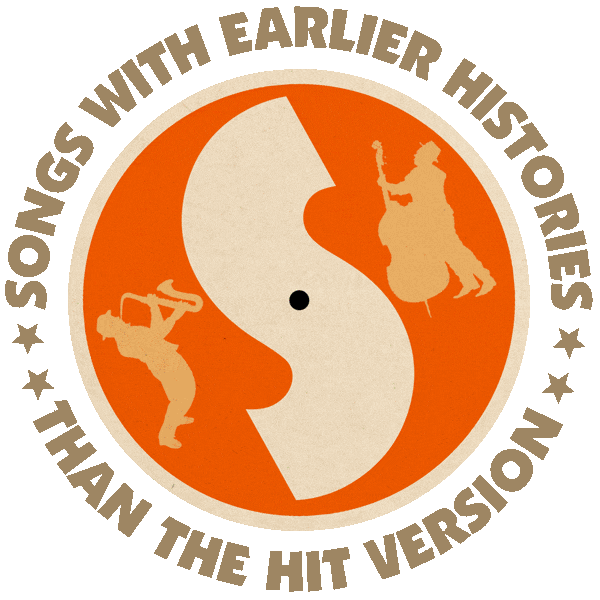Based on “The Bad in Every Man” by Shirley Ross (1934).
First recorded by Ted Fio Rito & His Orchestra (US #2 1934).
Other hit versions by Glen Gray & The Casa Loma Orchestra (US #1 1934), Connee Boswell (US #1 1935), Billy Eckstine (US #21 1949), Mel Tormé (US #20 1949), The Marcels (US #1/R&B #1/UK #1 1961).
Also recorded by Coleman Hawkins with the Michel Warlop Orchestra (1935), Elvis Presley (1954), Sam Cooke (1959).
From the wiki: “The melody to ‘Blue Moon’ goes back further than the first recorded version by Ted Fio Rito & His Orchestra. Richard Rodgers and Lorenz Hart were contracted to Metro-Goldwyn-Mayer in May 1933. They were soon commissioned to write the songs for Hollywood Party. ‘Prayer (Oh Lord, make me a movie star)’ was written for the movie but never recorded.
“Hart wrote new lyrics for the melody to create a title song for the 1934 film Manhattan Melodrama, but it was cut from the film before release. (Manhattan Melodrama wasn’t so much famous for having left what would become ‘Blue Moon’ on the edit room floor but for being the film John Dillinger went to see in the Chicago movie theater where he was gunned down by police bullets at the exit.) Rodgers still liked the melody so Hart wrote a third lyric, ‘The Bad in Every Man,’ which was sung by Shirley Ross. The song, which was also released as sheet music, was not a hit.
“Jack Robbins, the head of MGM studio’s publishing company, decided that the tune was suited to commercial release but needed more romantic lyrics and a punchier title. Hart was initially reluctant to write yet another lyric but was persuaded and the result – the FOURTH use of the melody – was ‘Blue moon/you saw me standing alone/without a dream in my heart/without a love of my own’.”
“Ted Fio Rito and his orchestra performed ‘Blue Moon’ as the theme song for the newly popular radio program Hollywood Hotel, hosted by gossip columnist Louella Parsons, when its broadcasts began on October 5, 1934. Fio Rito would take his group into a Los Angeles studio on October 19 to be the first to put ‘Blue Moon’ to disk. However, it would not see release until after Glen Gray’s Casa Loma Orchestra recorded its own arrangement on November 16, 1934, in New York City. While the Fio Rito recording charted respectively well, in the Top Ten, it was the Casa Loma recording that topped the national music chart by January, 1935.
“‘Blue Moon’ would subsequently be featured in at least seven other MGM films, including the Marx Brothers’ At the Circus (1939), and see almost continual release on record over the next three decades. In 1935, Coleman Hawkins recorded an instrumental version of ‘Blue Moon’ in Paris with the Michel Warlop Orchestra, including orchestra members Django Reinhardt and Stephane Grappelli. A Connee Boswell recording in 1935 again put the song at the top of the national music charts. Recordings by Billy Eckstine and Mel Tormé dueled each other for chart success in 1949.”
“From Originals.be:”Blue Moon’ was one of the songs Presley came up with for his second Sun Records session. Ballads were what he liked the most, where he could best express emotions, intriguing producer and Sun Records owner Sam Phillips, because these emotions kept sentimentality at bay (‘I don’t sound like nobody’, Elvis famously said).
“‘Up till then all versions of ‘Blue Moon’ sounded sentimental; all these crooners from the forties and thirties seemed to sing about another moon. Presley’s moon reflected in the efficient echo of the Sun studio, merely veiled by guitar and bass. All of a sudden ‘Blue Moon’ stopped sounding like an airbrushed second-hand wishing card.’
“Sam Cooke recorded a little-known version of ‘Blue Moon’, on his 1960 album The Wonderful World of Sam Cooke released on the KEEN record label – Cooke’s last record with that label before moving on to RCA Victor.
“By far the best-known and most popular version of ‘Blue Moon’ was recorded by The Marcels, in 1961. From Songfacts.com: ‘Producer Stu Phillips was ordered by his boss not to waste time on The Marcels and to spend his days devoted to a different artist at Colpix Records. But he didn’t say anything about his nights. Phillips waited until everyone else had gone home and sneaked the band into the studio for a secret session. They recorded this at the last minute after recording three songs but needing a fourth side. When one of the members said he knew ‘Blue Moon’, Phillips told him to teach the song to the rest of the group in an hour, then they’d record it.
“‘The Marcels recorded ‘Blue Moon’ in two takes. A promotion man asked for and got a copy of the finished tape, which then found its way to legendary radio disc-jockey Murray The K. He promoted it as an ‘exclusive’ and played it 26 times on one show.'”
Ted Fio Rito & His Orchestra, “Blue Moon” (1934):
Glen Gray & The Casa Loma Orchestra, “Blue Moon” (1934):
Coleman Hawkins with the Michel Warlop Orchestra, “Blue Moon” (1935):
Connee Boswell, “Blue Moon” (1935):
Mel Tormé, “Blue Moon” (1947):
https://youtu.be/WEt3PhCJOwA
Billy Eckstine, “Blue Moon” (1947):
Elvis Presley, “Blue Moon” (1954):
Sam Cooke, “Blue Moon” (1960):
The Marcels, “Blue Moon” (1961):

